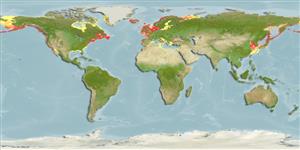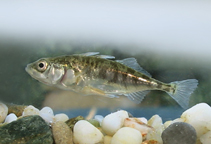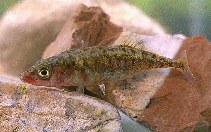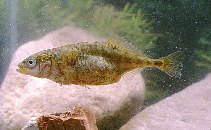Gasterosteus aculeatus Linnaeus, 1758
Three-spined stickleback
添加你自己的观测位置在 Fish Watcher
| Native range | All suitable habitat | Point map | Year 2050 |

|
| This map was computer-generated and has not yet been reviewed. |
| Gasterosteus aculeatus AquaMaps Data sources: GBIF OBIS |
Belarus country information
Common names:
Trekhiglaja koliushka
Occurrence: native
Salinity: freshwater
Abundance: | Ref:
Importance: | Ref:
Aquaculture: | Ref:
Regulations: | Ref:
Uses: no uses
Comments: Natural range extension from the Baltic Sea basin (Ref. 59054). On the basis of morphological parameters study, Gasterosteus aculeatus could arrive at the Pripyat River basin from the lower Dnieper River. Records in Belarus: Basins of the rivers Neman, Zapadnyi Bug (Fishes: popular encyclopedia 1989); Dnieper River and it tributaries (Zhukov et al. 1986; Fishes: popular encyclopedia 1989; Kunitskiy 2001). Potential ecological impacts: Gasterosteus aculeatus is a typical coarse fish, which competes for food with commercially important fish species and eats roe of the latter. In many waterbodies, threespine stickleback serves as an intermediate host in life cycles of birds' helminthes (Zhukov 1988).
National Checklist:
Country Information: https://www.cia.gov/library/publications/resources/the-world-factbook/geos/bo.html
National Fisheries Authority:
Occurrences: Occurrences Point map
Main Ref: Blanc, M., J.-L. Gaudet, P. Banarescu and J.-C. Hureau, 1971
National Database:
Occurrence: native
Salinity: freshwater
Abundance: | Ref:
Importance: | Ref:
Aquaculture: | Ref:
Regulations: | Ref:
Uses: no uses
Comments: Natural range extension from the Baltic Sea basin (Ref. 59054). On the basis of morphological parameters study, Gasterosteus aculeatus could arrive at the Pripyat River basin from the lower Dnieper River. Records in Belarus: Basins of the rivers Neman, Zapadnyi Bug (Fishes: popular encyclopedia 1989); Dnieper River and it tributaries (Zhukov et al. 1986; Fishes: popular encyclopedia 1989; Kunitskiy 2001). Potential ecological impacts: Gasterosteus aculeatus is a typical coarse fish, which competes for food with commercially important fish species and eats roe of the latter. In many waterbodies, threespine stickleback serves as an intermediate host in life cycles of birds' helminthes (Zhukov 1988).
National Checklist:
Country Information: https://www.cia.gov/library/publications/resources/the-world-factbook/geos/bo.html
National Fisheries Authority:
Occurrences: Occurrences Point map
Main Ref: Blanc, M., J.-L. Gaudet, P. Banarescu and J.-C. Hureau, 1971
National Database:
Common names from other countries
分类 / Names 俗名 | 同种异名 | Catalog of Fishes(属, 种) | ITIS | CoL | WoRMS | Cloffa
Teleostei > Perciformes/Gasterosteoidei (Sticklebacks) > Gasterosteidae (Sticklebacks and tubesnouts)
Etymology: Gasterosteus: Greek, gaster = stomach + Greek, osteon = bone (Ref. 45335); aculeatus: aculeatus meaning spined (Ref. 1998).
More on author: Linnaeus.
Etymology: Gasterosteus: Greek, gaster = stomach + Greek, osteon = bone (Ref. 45335); aculeatus: aculeatus meaning spined (Ref. 1998).
More on author: Linnaeus.
Environment: milieu / climate zone / depth range / distribution range 生态学
海洋; 淡水; 半咸淡水 底中水层性; 溯河洄游 (Ref. 51243); 深度上下限 0 - 100 m (Ref. 50550). 溫帶; 4°C - 20°C (Ref. 1672); 72°N - 25°N, 117°E - 60°E (Ref. 26213)
分布 国家 | FAO区域 | 生态系 | 标本纪录 | Point map | 简介 | Faunafri
Circumarctic and temperate regions: Extending south to the Black Sea, southern Italy, Iberian Peninsula, North Africa; in Eastern Asia north of Japan (35°N), in North America north of 30-32°N; Greenland.
歐洲: 在大多數的河中﹐除了許多多瑙河系統; 也發現於地中海與黑海。 (參考文獻 1998) 非洲: 已知只來自在阿爾及耳附近的 Mifidja了。 北太平洋: 韓國到白令海與到墨西哥的下加利福尼亞; 在海洋中只當作如蒙德勒海灣,美國加州的遠南方。 (參考文獻 2850) 北大西洋: 到哈得遜灣與 Baffin 島的切薩皮克海灣.(參考文獻 1998) 亞洲: 伊朗.(參考文獻 39702)
歐洲: 在大多數的河中﹐除了許多多瑙河系統; 也發現於地中海與黑海。 (參考文獻 1998) 非洲: 已知只來自在阿爾及耳附近的 Mifidja了。 北太平洋: 韓國到白令海與到墨西哥的下加利福尼亞; 在海洋中只當作如蒙德勒海灣,美國加州的遠南方。 (參考文獻 2850) 北大西洋: 到哈得遜灣與 Baffin 島的切薩皮克海灣.(參考文獻 1998) 亞洲: 伊朗.(參考文獻 39702)
Length at first maturity / 大小 / 重量 / 年龄
Maturity: Lm 5.5 range ? - ? cm
Max length : 11.0 cm TL 雄鱼/尚未辨别雌雄; (Ref. 35388); common length : 5.1 cm TL 雄鱼/尚未辨别雌雄; (Ref. 1998); 最大年龄: 8 年 (Ref. 72489)
Max length : 11.0 cm TL 雄鱼/尚未辨别雌雄; (Ref. 35388); common length : 5.1 cm TL 雄鱼/尚未辨别雌雄; (Ref. 1998); 最大年龄: 8 年 (Ref. 72489)
简单描述 检索表 | 型态特徵 | 形态测量图
背棘 (总数) : 2 - 4; 背的软条 (总数) : 10 - 14; 臀棘: 1; 臀鳍软条: 7 - 11; 脊椎骨: 29 - 34. Distinguished uniquely from its congeners in Europe by having trunk and caudal peduncle covered by a complete series of 29-35 bony scutes. Other characters important to separate this species from other species of the genus include posterior edge of scutes crenulated and scutes forming a lateral keel on caudal peduncle. Scutes may be missing on posterior part of trunk in hybrid zone with Gasterosteus gymnurus and in some isolated freshwater populations of northeastern Europe (Ref. 59043). Identified by the 3 to 4 sharp, free spines before the dorsal fin, the pelvic fin reduced to a sharp spine and a small ray, and the series of plates along the sides of the body (Ref. 27547). Gill rakers long and slender, 17 to 25 on the first arch or strictly freshwater forms, 1 or 2 more in anadromous forms; lateral line with microscopic pores (Ref. 27547). The anadromous form is fully plated, with up to 37 plates on the sides and a rather pronounced keel on each side of the caudal peduncle (Ref. 27547). Dorsal spines separated from each other and from the soft-rayed fins, each spine having a reduced membrane attached to its posterior side; anal spine free from rest of the fin; posterior margin of pectorals nearly truncate; caudal truncate to slightly indented (Ref. 27547). Freshwater forms usually mottled brown or greenish; anadromous forms silvery green to bluish black (Ref. 27547). A few isolated populations are black (Ref. 27547). Sides usually pale; belly yellow, white or silvery (Ref. 27547). Fins pale; pectoral rays often have dark dots (Ref. 27547). Breeding males (except for black forms) become brilliant bluish or green with blue or green eyes, and the forward part of the body, especially the breast region, turns bright red or orange (Ref. 27547). Caudal fin with 12 rays (Ref. 2196).
在背鳍之前鉴定特徵为 3 到 4根锐利又自由的棘了, 腹鳍缩小成一根锐利的棘与一个小的鳍条了,而且成列的碟沿着身体的侧边。 (参考文献 27547) 鳃耙长且细的,17 到 25 在第一个弓或完全淡水的表格上, 在溯河洄游产卵的造型中的 1 或 2 更多; 侧线有微小的孔。 (参考文献 27547) 溯河洄游产卵的形式完全甲胄, 侧边上多达 37个碟与在尾梗的两边上一个相当明显的龙骨脊。 (参考文献 27547) 背棘与彼此与从有软鳍的鳍分开了,有一个的每根棘缩小的被依附于它的在后部侧边的薄膜了; 臀鳍硬棘分离其余的鳍; 胸鳍的后缘几乎截形; 尾部的截形到些微地切割成锯齿状.(参考文献 27547) 淡水的类型通常褐色班点或呈绿色的; 溯河洄游产卵的造型银色的绿色到蓝黑色的.(参考文献 27547) 一些孤立的族群是黑色的。 (参考文献 27547) 侧边通常灰白的; 腹面黄色的,白色的或银色的.(参考文献 27547) 鳍灰白的; 胸鳍鳍条时常有深色的点。 (参考文献 27547) 繁殖期的雄性 (除了黑色的造型) 变成色彩艳丽蓝色或者绿色的有蓝色或者绿色的眼, 与身体的向前部份尤其胸部区域, 变鲜红色或橘色.(参考文献 27547) 尾鳍有 12个鳍条。 (参考文献 2196)
在背鳍之前鉴定特徵为 3 到 4根锐利又自由的棘了, 腹鳍缩小成一根锐利的棘与一个小的鳍条了,而且成列的碟沿着身体的侧边。 (参考文献 27547) 鳃耙长且细的,17 到 25 在第一个弓或完全淡水的表格上, 在溯河洄游产卵的造型中的 1 或 2 更多; 侧线有微小的孔。 (参考文献 27547) 溯河洄游产卵的形式完全甲胄, 侧边上多达 37个碟与在尾梗的两边上一个相当明显的龙骨脊。 (参考文献 27547) 背棘与彼此与从有软鳍的鳍分开了,有一个的每根棘缩小的被依附于它的在后部侧边的薄膜了; 臀鳍硬棘分离其余的鳍; 胸鳍的后缘几乎截形; 尾部的截形到些微地切割成锯齿状.(参考文献 27547) 淡水的类型通常褐色班点或呈绿色的; 溯河洄游产卵的造型银色的绿色到蓝黑色的.(参考文献 27547) 一些孤立的族群是黑色的。 (参考文献 27547) 侧边通常灰白的; 腹面黄色的,白色的或银色的.(参考文献 27547) 鳍灰白的; 胸鳍鳍条时常有深色的点。 (参考文献 27547) 繁殖期的雄性 (除了黑色的造型) 变成色彩艳丽蓝色或者绿色的有蓝色或者绿色的眼, 与身体的向前部份尤其胸部区域, 变鲜红色或橘色.(参考文献 27547) 尾鳍有 12个鳍条。 (参考文献 2196)
Adults occur in fresh waters, estuaries and coastal seas (Ref. 4119). Anadromous, with numerous non-anadromous populations in brackish or pure freshwater, rarely in marine waters. In the sea, confined to coastal waters. In freshwater, adults prefer to live in small stream but may occur in a variety of habitats including lakes and large rivers (Ref. 59043). Inhabit shallow vegetated areas, usually over mud or sand (Ref. 5723). Form schools. Young associated with drifting seaweed (Ref. 12114, 12115). Juveniles move to the sea (anadromous populations) or to deeper, larger water bodies (freshwater populations) in July-August, forming large feeding schools (Ref. 59043). Feed on worms, crustaceans, larvae and adult aquatic insects, drowned aerial insects, and small fishes; has also been reported to feed on their own fry and eggs (Ref. 1998). Eggs are found in nests constructed from plant material (Ref. 41678). Males build, guard and aerate the nest where the eggs are deposited (Ref. 205). Maximum length in freshwater is 8 cm while in saltwater is 11 cm (Ref. 35388). Occasionally taken commercially in Scandinavia and processed into fishmeal and oil (Ref. 28219, 28964). Commonly used as a laboratory animal (Ref. 1998). A large bibliography is available at www.geocities.com/CapeCanaveral/Hall/1345/stickbibl.html.
栖息于有植物生长的区域, 通常在泥或沙子上面.(参考文献 5723) 在海洋中, 局限于沿岸水域。 形成鱼群。 幼鱼伴随着漂流的海草了。 (参考文献 12114,12115) 卵被发现于由植物构成的巢。 (参考文献 41678) 吃蠕虫,甲壳动物, 仔鱼与被淹死陆生昆虫 , 与小鱼的成鱼水生昆虫; 已经也被报告觅食他们自己的鱼苗与卵.(参考文献 1998) 长度在淡水中是 8 公分然而在盐水的是 11 公分.(参考文献 35388) 偶然地在斯堪的那维亚半岛商业地采而且加工成鱼浆或鱼油.(参考文献 28219,28964) 通常用作了一个实验用动物 (参考文献 1998) ,而且一个大的参考书目在 www.geocities.com/CapeCanaveral/门厅/1345/ stickbibl.html 是有用的。
栖息于有植物生长的区域, 通常在泥或沙子上面.(参考文献 5723) 在海洋中, 局限于沿岸水域。 形成鱼群。 幼鱼伴随着漂流的海草了。 (参考文献 12114,12115) 卵被发现于由植物构成的巢。 (参考文献 41678) 吃蠕虫,甲壳动物, 仔鱼与被淹死陆生昆虫 , 与小鱼的成鱼水生昆虫; 已经也被报告觅食他们自己的鱼苗与卵.(参考文献 1998) 长度在淡水中是 8 公分然而在盐水的是 11 公分.(参考文献 35388) 偶然地在斯堪的那维亚半岛商业地采而且加工成鱼浆或鱼油.(参考文献 28219,28964) 通常用作了一个实验用动物 (参考文献 1998) ,而且一个大的参考书目在 www.geocities.com/CapeCanaveral/门厅/1345/ stickbibl.html 是有用的。
Life cycle and mating behavior 成熟度 | 繁殖 | 产卵场 | 卵 | 孕卵数 | 仔鱼
Spawning behavior is similar for both freshwater and anadromous forms (Ref. 28966). Just before breeding, males become very territorial. The male builds a nest of plant-material glued together with spiggin, a protein produced in the kidney (Ref. 52349). Once a nest is built, the male entices the female into the nest by performing a courtship dance which is a series of zigzag movements (Ref. 1998). A receptive female follows the male who points the opening of the nest by posing above it with his head down. The female enters the nest, deposits up to a few hundred eggs, and is driven out by the male after eggs have been deposited. The male then enters the nest to fertilize the eggs. The male can choose to court another female to enter the nest and lay eggs before entering himself to fertilise the deposited eggs. Females may lay eggs in several nests over a period of several days or may be courted by the same male (Ref. 27547). The male guards and ventilates the eggs and young (Ref. 1998). During spawning season, males develop a bright orange to red belly and blue-green flank and eyes. Eggs hatch in 7-8 days. Anadromous forms usually die of exhaustion after spawning cycle. Freshwater individuals are able to complete several cycles within one year or sometimes over several years (Ref. 59043).歐洲: 在大多數的河中﹐除了許多多瑙河系統; 也發現於地中海與黑海。 (參考文獻 1998) 非洲: 已知只來自在阿爾及耳附近的 Mifidja了。 北太平洋: 韓國到白令海與到墨西哥的下加利福尼亞; 在海洋中只當作如蒙德勒海灣,美國加州的遠南方。 (參考文獻 2850) 北大西洋: 到哈得遜灣與 Baffin 島的切薩皮克海灣.(參考文獻 1998) 亞洲: 伊朗.(參考文獻 39702)
主要参考文献
Upload your references | 参考文献 | 合作者 | 合作者
Page, L.M. and B.M. Burr, 2011. A field guide to freshwater fishes of North America north of Mexico. Boston : Houghton Mifflin Harcourt, 663p. (Ref. 86798)
对人类的威胁
无害处的
人类利用
渔业: 低经济; 水族馆: 公众的水族馆
FAO(Aquaculture systems: 产生; 渔业: 产生; publication : search) | FishSource | 周边海洋
更多信息
Population dynamics
成长参数
Max. ages / sizes
Length-weight rel.
Length-length rel.
体长-频率
Mass conversion
入添量
丰度
成长参数
Max. ages / sizes
Length-weight rel.
Length-length rel.
体长-频率
Mass conversion
入添量
丰度
Physiology
Body composition
Nutrients
耗氧量
游泳类型
游泳速度
Visual pigments
Fish sound
Diseases & Parasites
Toxicity (LC50s)
Body composition
Nutrients
耗氧量
游泳类型
游泳速度
Visual pigments
Fish sound
Diseases & Parasites
Toxicity (LC50s)
工具
Bio-Quiz | E-book | 野外调查 | 检索表 | 长度- 频率 Wizard | 生活- 历史的工具 | 分布图 | Classification Tree
| Catch-MSY |
特别资料
下载 XML
网络资源
Alien/Invasive Species database | Aquatic Commons | BHL | Cloffa | BOLDSystems | Websites from users | 核实 FishWatcher | CISTI | Catalog of Fishes(属, 种) | DiscoverLife | DORIS | ECOTOX | Faunafri | Fishtrace | GenBank(基因组, 核苷酸) | GloBI | GOBASE | | Google Books | Google Scholar | Google | IGFA World Record | MitoFish | 国家资料库 | Otolith Atlas of Taiwan Fishes | 公众的水族馆 | PubMed | Reef Life Survey | Scirus | SeaLifeBase | 树状分类阶层 | Wikipedia(转至, 搜寻) | World Records Freshwater Fishing | Zoobank | 动物学的记录
Estimates based on models
Preferred temperature (Ref. 115969): 2 - 13.5, mean 8 (based on 2296 cells).
Phylogenetic diversity index (Ref. 82804): PD50 = 0.5156 [Uniqueness, from 0.5 = low to 2.0 = high].
Bayesian length-weight: a=0.00977 (0.00662 - 0.01443), b=3.09 (2.99 - 3.19), in cm Total Length, based on LWR estimates for this species (Ref. 93245).
营养阶层 (Ref. 69278): 3.3 ±0.2 se; based on diet studies.
回复力 (Ref. 120179): 高度, 族群倍增时间少于 15个月 (K=0.6-1.8; tm=1; tmax=4; Fec=80).
Fishing Vulnerability (Ref. 59153): Low vulnerability (10 of 100).
Climate Vulnerability (Ref. 125649): Low to moderate vulnerability (26 of 100).







